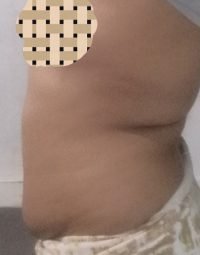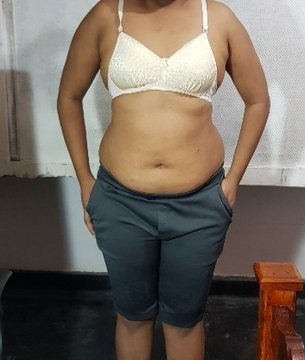FORCA?Fellow One Research Combined Average (FORCA) Health Score which Averages the Self-Determined (SD) Health & FORC Health Scores [5 is Very Healthy, 1 is Very Unhealthy]. This score is in beta testing.
2.48
FORTH?Fellow One Research Total Health (FORTH) Score [5 is Very Healthy, 1 is Very Unhealthy]. This score is in beta testing.
2.31
FORMR?Fellow One Research Metabolism Rate (FORMR) Adjusted Mifflin St Jeor Equation BMR (Basal Metabolic Rate) Score. This score is in beta testing.
Normal Metabolism
Mifflin St Jeor BMR: 1517.07
Adjusted Mifflin St Jeor: 1423.77
FORMA?Fellow One Research Metabolism Activity (FORMA) Adjusted Harris-Benedict Equation Activity Score. This score is in beta testing.
Steady Metabolic Rate
Body Mass Index (BMI) Calculation
31
BMI Minimal, Moderate, High Risk
High Risk
Diary Data - Started on 05-07-21
Back Side Facing Angle
Full Back Facing Angle
Full Front Midriff Facing Angle
Anticipated Underdeveloped / Undeveloped Vertebrae
15
Starting Weight
175.1 lb
Weight Loss Goal
121 lb
Weight Difference to Date
-16.6 lb
Cheat Days
1
| Date | Current Weight | Type of Diet | Breakfast | Breakfast Calories | Lunch | Lunch Calories | Dinner | Dinner Calories | Snacks | Snacks Calories | Total Calories | Organic Whole Food % | Regular Whole Food % | Junk/Processed/Fast Food % | Percentage of Diet, Carnivore | Percentage of Diet, Vegetarian | Percentage of Diet, Vegan | Water (oz) Total | Filter Water % | Tap Water % | Spring Water % | Bottled Water % | Total Protein (g) | Total Fat (g) | Total Monounsaturated Fat (g) | Total Polyunsaturated Fats (g) | Total Saturated Fat (g) | Total Trans Fat (g) | Cholesterol (mg) | Omega 3 Fatty Acids (EPA/DHA) | Omega 3 Source(s) | Total Carbohydrates (g) | Fiber (Carbs)(g) | Total Sugar (Carbs)(g) | Added Sugar (Carbs)(g) | Total Sodium (mg) | Vitamin Supplements, Doses | Vitamins, Type(s) | Vitamins, Kind(s) | Vitamins, Source Quality | Heart Rate (resting) | Heart Rate (post) | Blood Pressure Systolic (resting) | Blood Pressure Systolic (post) | Blood Pressure Diastolic (resting) | Blood Pressure Diastolic (post) | Type of Cardio Exercise | Total Cardio Exercise Duration (minutes) | Total Steps | Total Flights Climbed | Total Laps (Swimming) | Estimated Calories Burned, Cardio | Type of Resistance Exercise | Total Resistance Exercise Duration (Minutes) | Estimated Calories Burned, Resistance | Sleep Duration (hours) | Sleep Quality | Allopathic Meds, Doses | Allopathic Meds | Herbal & Other Supplements, Doses | Herbal & Other Supplements | Caffeine | Caffeine Amount | Alcohol Servings | Nicotine Intake | Nicotine Amount | Cannabis | Cannabis Amount | Negative Behaviors | Negative Behavior Source | Overall Level of Stress | Cheat Day | Cheat Reason |
|---|---|---|---|---|---|---|---|---|---|---|---|---|---|---|---|---|---|---|---|---|---|---|---|---|---|---|---|---|---|---|---|---|---|---|---|---|---|---|---|---|---|---|---|---|---|---|---|---|---|---|---|---|---|---|---|---|---|---|---|---|---|---|---|---|---|---|---|---|---|---|---|---|---|
| 05-7-21 | 175.1 | Low-Carb | Intermittent Fasting | 0 | Chicken peanuts coconut oil cabbage | 710 | pineapple juice | 65 | 0 | 0 | 775 | 40 | 60 | 0 | 100 | 0 | 0 | 60 | 100 | 0 | 0 | 0 | 52 | 60 | 0 | 0 | 0 | 0 | 0 | No | None | 30 | 0 | 0 | 0 | 0 | 0 | No Vitamins Taken | 70 | 74 | 110 | 115 | 70 | 72 | Walking | 60 | 5100 | 0 | 0 | 120 | None | 0 | 0 | 8 | OK | 0 | Private | 0 | Private | Coffee | Moderate (3 Cups of Coffee, or comparable) | None | None | None | 0 | No | Private | Very Low | No | ||||
| 05-8-21 | 174 | Low-Carb | intermittent fasting | 0 | Rice Fish coconut milk | 200 | Peanuts coconut water coconut meat | 600 | 0 | 0 | 800 | 60 | 40 | 0 | 100 | 0 | 0 | 0 | 100 | 0 | 0 | 0 | 50 | 64 | 0 | 0 | 0 | 0 | 0 | No | None | 31 | 0 | 0 | 0 | 0 | 0 | No Vitamins Taken | 70 | 80 | 110 | 112 | 75 | 80 | Walking | 60 | 5390 | 0 | 0 | 190 | None | 0 | 0 | 6 | OK | 0 | Private | 0 | Private | Coffee | Low (2 Cups of Coffee, or comparable) | None | None | None | 0 | No | Private | Very Low | No | ||||
| 05-9-21 | 174 | Low-Carb | intermittent fasting | 0 | Chicken olive oil cucumber cauliflower | 410 | Mango juice | 100 | peanuts | 350 | 860 | 100 | 0 | 0 | 50 | 50 | 0 | 60 | 100 | 0 | 0 | 0 | 52 | 60 | 0 | 0 | 0 | 0 | 0 | No | None | 30 | 12 | 28 | 0 | 0 | 0 | No Vitamins Taken | 70 | 75 | 110 | 112 | 72 | 74 | Walking | 60 | 5480 | 0 | 0 | 180 | None | 0 | 0 | 7 | OK | 0 | Private | 0 | Private | Coffee | Very Low (1 Cup of Coffee or less, or comparable) | None | None | None | 0 | No | Private | Low | No | ||||
| 05-10-21 | 174 | Low-Carb | Intermittent fasting | 0 | Fish Coconut oil Peanuts | 560 | Watermelon juice | 65 | Cheese | 120 | 745 | 50 | 40 | 10 | 100 | 0 | 0 | 55 | 100 | 0 | 0 | 0 | 52 | 65 | 0 | 0 | 0 | 0 | 0 | No | None | 35 | 0 | 0 | 0 | 0 | 0 | No Vitamins Taken | 70 | 77 | 110 | 115 | 70 | 75 | Walking | 60 | 6000 | 0 | 0 | 120 | None | 0 | 0 | 7 | Unrestful | 0 | Private | 0 | Private | Coffee | Low (2 Cups of Coffee, or comparable) | None | None | None | 0 | No | Private | Very Low | No | ||||
| 05-12-21 | 173.5 | Low-Carb | Intermittent fasting | 0 | Chicken Cauliflower Onions Olive oil | 450 | Watermelon juice Cashew nuts | 300 | 0 | 0 | 750 | 50 | 50 | 0 | 100 | 0 | 0 | 55 | 100 | 0 | 0 | 0 | 70 | 65 | 0 | 0 | 0 | 0 | 0 | No | None | 35 | 0 | 0 | 0 | 0 | 0 | No Vitamins Taken | 70 | 77 | 110 | 112 | 75 | 77 | Walking | 60 | 5147 | 0 | 0 | 111 | None | 0 | 0 | 7 | Very Unrestful | 0 | Private | 0 | Private | Coffee | Low (2 Cups of Coffee, or comparable) | None | None | None | 0 | No | Private | Very Low | No | ||||
| 05-13-21 | 173 | Low-Carb | Intermittent fasting | 0 | Fish Coconut chutney Rice | 330 | Coconut water Chicken Olive oil | 500 | 0 | 0 | 830 | 50 | 50 | 0 | 100 | 0 | 0 | 55 | 100 | 0 | 0 | 0 | 75 | 52 | 0 | 0 | 0 | 0 | 0 | No | None | 40 | 0 | 0 | 0 | 0 | 0 | No Vitamins Taken | 70 | 74 | 110 | 112 | 70 | 72 | Walking | 60 | 5480 | 0 | 0 | 120 | None | 0 | 0 | 7 | Very Unrestful | 0 | Private | 0 | Private | Coffee | Low (2 Cups of Coffee, or comparable) | None | None | None | 0 | No | Private | Very Low | No | ||||
| 05-14-21 | 174.1 | Low-Carb | Intermittent fasting | 0 | Vegetables Chicken | 350 | Chicken Rice Coconut oil | 450 | Nuts Chocolate | 325 | 1125 | 30 | 40 | 30 | 100 | 0 | 0 | 55 | 100 | 0 | 0 | 0 | 52 | 50 | 0 | 0 | 0 | 0 | 0 | No | None | 65 | 0 | 0 | 0 | 0 | 0 | No Vitamins Taken | 69 | 75 | 110 | 115 | 70 | 74 | Walking | 60 | 5300 | 0 | 0 | 120 | None | 0 | 0 | 8 | Very Unrestful | 0 | Private | 0 | Private | Coffee | Very Low (1 Cup of Coffee or less, or comparable) | None | None | None | 0 | No | Private | High | Yes | Menstrual cravings | |||
| 05-15-21 | 174 | Low-Carb | Intermittent fasting | 0 | Dry fish Coconut oil Rice Cabbage | 400 | Coconut water Pineapple juice Vegetable salad with mayonnaise | 380 | Mango | 50 | 730 | 80 | 20 | 0 | 100 | 0 | 0 | 45 | 100 | 0 | 0 | 0 | 70 | 56 | 0 | 0 | 0 | 0 | 0 | No | None | 65 | 0 | 0 | 0 | 0 | 0 | No Vitamins Taken | 70 | 77 | 112 | 115 | 70 | 74 | Walking | 60 | 5420 | 0 | 0 | 0 | None | 0 | 0 | 8 | OK | 0 | Private | 0 | Private | None | None | None | None | 0 | No | Private | Very Low | No | |||||
| 05-17-21 | 173 | Low-Carb | intermittent fasting | 0 | pork carrot coconut meat | 550 | fish olive oil | 350 | mango | 50 | 950 | 0 | 0 | 0 | 0 | 0 | 0 | 60 | 100 | 0 | 0 | 0 | 80 | 100 | 0 | 0 | 0 | 0 | 0 | No | None | 35 | 0 | 0 | 0 | 0 | 0 | No Vitamins Taken | 70 | 75 | 77 | 73 | 78 | 80 | Walking | 60 | 5000 | 0 | 0 | 120 | None | 0 | 0 | 8 | Very Unrestful | 0 | Private | 0 | Private | None | None | None | None | 0 | No | Private | Very Low | No | |||||
| 05-18-21 | 173 | Low-Carb | intermittent fasting | 0 | chicken coconut oil beans | 420 | rice carrots leeks chicken sausages | 400 | mango | 80 | 900 | 50 | 50 | 0 | 100 | 0 | 0 | 0 | 100 | 0 | 0 | 0 | 85 | 100 | 0 | 0 | 0 | 0 | 0 | No | None | 40 | 0 | 0 | 0 | 0 | 0 | No Vitamins Taken | 72 | 80 | 118 | 123 | 77 | 82 | Walking | 60 | 5100 | 0 | 0 | 120 | None | 0 | 0 | 8 | OK | 0 | Private | 0 | Private | Coffee | Moderate (3 Cups of Coffee, or comparable) | None | None | None | 0 | No | Private | Very Low | No | ||||
| 05-20-21 | 173 | Low-Carb | Intermittent fasting | 0 | Cauliflower grilled cheese | 500 | Peanuts Fish | 400 | Mango | 50 | 950 | 50 | 50 | 0 | 0 | 0 | 0 | 55 | 100 | 0 | 0 | 0 | 70 | 50 | 0 | 0 | 0 | 0 | 0 | No | None | 30 | 0 | 0 | 0 | 0 | 0 | No Vitamins Taken | 70 | 77 | 110 | 115 | 75 | 77 | Walking | 60 | 5147 | 0 | 0 | 120 | None | 0 | 0 | 8 | OK | 0 | Private | 0 | Private | Coffee | Low (2 Cups of Coffee, or comparable) | None | None | None | 0 | No | Private | Very Low | No | ||||
| 05-21-21 | 172 | Low-Carb | Intermittent fasting | 0 | Prawns Rice Coconut oil Cabbage | 450 | Omlet | 200 | Mango | 50 | 900 | 50 | 50 | 0 | 0 | 0 | 0 | 55 | 0 | 0 | 0 | 0 | 65 | 50 | 0 | 0 | 0 | 0 | 0 | No | None | 40 | 0 | 0 | 0 | 0 | 0 | No Vitamins Taken | 72 | 76 | 110 | 115 | 75 | 80 | None | 60 | 5200 | 0 | 0 | 120 | None | 0 | 0 | 8 | OK | 0 | Private | 0 | Private | Coffee | Low (2 Cups of Coffee, or comparable) | None | None | None | 0 | No | Private | Very Low | No | ||||
| 05-22-21 | 170 | Low-Carb | intermittent fasting | 0 | Chicken sausages cucumber olives | 400 | Dhal eggs coconut coconut oil | 500 | mango cashew nut | 250 | 1150 | 50 | 25 | 25 | 100 | 0 | 0 | 55 | 100 | 0 | 0 | 0 | 100 | 60 | 0 | 0 | 0 | 0 | 0 | No | None | 55 | 0 | 0 | 0 | 0 | 0 | No Vitamins Taken | 72 | 77 | 110 | 112 | 80 | 82 | Walking | 60 | 5100 | 0 | 0 | 120 | None | 0 | 0 | 7 | Restful | 0 | Private | 0 | Private | None | None | None | None | 0 | No | Private | Very Low | No | |||||
| 05-23-21 | 170 | Low-Carb | Intermittent fasting | 0 | Fish Olive oil Coconut meat | 400 | Chicken sausages Carrots Leeks Cabbage Coconut oil | 500 | Dark chocolate | 100 | 1000 | 50 | 25 | 25 | 100 | 0 | 0 | 55 | 100 | 0 | 0 | 0 | 70 | 85 | 0 | 0 | 0 | 0 | 0 | No | None | 50 | 0 | 0 | 0 | 0 | 0 | No Vitamins Taken | 70 | 75 | 110 | 112 | 75 | 77 | Walking | 60 | 5020 | 0 | 0 | 100 | None | 0 | 0 | 8 | OK | 0 | Private | 0 | Private | Coffee | None | None | None | 0 | No | Private | Very Low | No | |||||
| 05-25-21 | 170 | Low-Carb | IF | 0 | Swiss cheese Chicken Vegetables | 400 | Eggs Olive oil Carrot Leeks | 350 | Mango | 150 | 900 | 50 | 50 | 0 | 100 | 0 | 0 | 55 | 100 | 0 | 0 | 0 | 65 | 85 | 0 | 0 | 0 | 0 | 0 | No | None | 40 | 0 | 0 | 0 | 0 | 0 | No Vitamins Taken | 70 | 75 | 110 | 112 | 75 | 77 | Walking | 60 | 5000 | 0 | 0 | 100 | None | 0 | 0 | 11 | Very Restful | 0 | Private | 0 | Private | Coffee | Low (2 Cups of Coffee, or comparable) | None | None | None | 0 | No | Private | Very Low | No | ||||
| 05-26-21 | 169 | Low-Carb | Intermittent fasting | 0 | Chicken Beans Cabbage Olive oil | 450 | Fish Peanuts Spinach Olive oil | 450 | Peanuts Milk | 200 | 1100 | 50 | 50 | 0 | 100 | 0 | 0 | 60 | 100 | 0 | 0 | 0 | 66 | 50 | 0 | 0 | 0 | 0 | 0 | No | None | 35 | 0 | 0 | 0 | 0 | 0 | No Vitamins Taken | 72 | 77 | 110 | 115 | 77 | 80 | Walking | 60 | 5000 | 0 | 0 | 100 | None | 0 | 0 | 7 | Unrestful | 0 | Private | 0 | Private | Coffee | Moderate (3 Cups of Coffee, or comparable) | None | None | None | 0 | No | Private | Very Low | No | ||||
| 05-27-21 | 168 | Low-Carb | Intermittent fasting | 0 | Swiss cheese Chicken Pancake | 450 | Coconut Fish Coconut oil Rice | 450 | Mango | 100 | 1000 | 50 | 50 | 0 | 100 | 0 | 0 | 60 | 100 | 0 | 0 | 0 | 66 | 50 | 0 | 0 | 0 | 0 | 0 | No | None | 40 | 0 | 0 | 0 | 0 | 0 | No Vitamins Taken | 70 | 75 | 110 | 112 | 70 | 77 | None | 60 | 5100 | 0 | 0 | 120 | None | 0 | 0 | 7 | Unrestful | 0 | Private | 0 | Private | Coffee | Low (2 Cups of Coffee, or comparable) | None | None | None | 0 | No | Private | Very Low | No | ||||
| 05-30-21 | 168 | Low-Carb | Intermittent fasting | 0 | Bee honey Chicken Swiss cheese Vegetables | 600 | Prawns Vegetables Olive oil | 450 | 0 | 0 | 1050 | 50 | 50 | 0 | 100 | 0 | 0 | 60 | 100 | 0 | 0 | 0 | 70 | 50 | 0 | 0 | 0 | 0 | 0 | No | None | 40 | 0 | 0 | 0 | 0 | 0 | No Vitamins Taken | 70 | 75 | 110 | 112 | 75 | 77 | Walking | 60 | 5123 | 0 | 0 | 120 | None | 0 | 0 | 7 | Very Unrestful | 0 | Private | 0 | Private | Coffee | Low (2 Cups of Coffee, or comparable) | None | None | None | 0 | No | Private | Very Low | No | ||||
| 05-31-21 | 167 | Low-Carb | Intermittent fasting | 0 | Prawns Vegetables Olive oil | 400 | Omelette Swiss cheese | 300 | Mango | 100 | 800 | 50 | 50 | 0 | 100 | 0 | 0 | 60 | 100 | 0 | 0 | 0 | 55 | 50 | 0 | 0 | 0 | 0 | 0 | No | None | 35 | 0 | 0 | 0 | 0 | 0 | No Vitamins Taken | 72 | 77 | 110 | 115 | 75 | 77 | Walking | 60 | 5200 | 0 | 0 | 120 | None | 0 | 0 | 7 | OK | 0 | Private | 0 | Private | None | None | None | None | 0 | No | Private | Very Low | No | |||||
| 06-1-21 | 167 | Low-Carb | Intermittent fasting | 0 | Prawns Olive oil Vegetables | 450 | Swiss cheese Omelet | 250 | Avacado juice | 200 | 900 | 50 | 50 | 0 | 100 | 0 | 0 | 60 | 100 | 0 | 0 | 0 | 55 | 50 | 0 | 0 | 0 | 0 | 0 | No | None | 20 | 0 | 0 | 0 | 0 | 0 | No Vitamins Taken | 70 | 75 | 110 | 112 | 70 | 75 | Walking | 60 | 5100 | 0 | 0 | 110 | None | 0 | 0 | 7 | OK | 0 | Private | 0 | Private | Coffee | Moderate (3 Cups of Coffee, or comparable) | None | None | None | 0 | No | Private | Very Low | No | ||||
| 06-2-21 | 164.6 | Low-Carb | Intermittent fasting | 0 | Sausages Swiss cheese Omelet Olive oil | 450 | Vegetables Chicken Coconut Coconut oil | 450 | Peanuts | 150 | 1050 | 50 | 50 | 0 | 100 | 0 | 0 | 60 | 100 | 0 | 0 | 0 | 66 | 75 | 0 | 0 | 0 | 0 | 0 | No | None | 25 | 0 | 0 | 0 | 0 | 0 | No Vitamins Taken | 70 | 75 | 110 | 115 | 70 | 76 | Walking | 60 | 5120 | 0 | 0 | 120 | None | 0 | 0 | 7 | Unrestful | 0 | Private | 0 | Private | Coffee | Low (2 Cups of Coffee, or comparable) | None | None | None | 0 | No | Private | Very Low | No | ||||
| 06-5-21 | 164 | Blue Zone Mediterranean Diet | Intermittent fasting | 0 | Spinach Eggs Cheese Olive oil | 500 | Fish Rice Vegetables | 350 | Peanuts | 150 | 1000 | 50 | 50 | 0 | 100 | 0 | 0 | 60 | 100 | 0 | 0 | 0 | 55 | 50 | 0 | 0 | 0 | 0 | 0 | No | None | 40 | 0 | 0 | 0 | 0 | 0 | No Vitamins Taken | 70 | 75 | 110 | 115 | 70 | 77 | Walking | 60 | 5200 | 0 | 0 | 120 | None | 0 | 0 | 7 | OK | 0 | Private | 0 | Private | None | None | None | None | 0 | No | Private | Very Low | No | |||||
| 06-6-21 | 164 | Low-Carb | Intermittent fasting | 0 | Chicken Carrots Leeks Coconut oil Coconut | 550 | Omelet Swiss cheese Ev olive oil | 450 | Peanuts | 200 | 1200 | 50 | 50 | 0 | 100 | 0 | 0 | 60 | 100 | 0 | 0 | 0 | 55 | 50 | 0 | 0 | 0 | 0 | 0 | No | None | 20 | 0 | 0 | 0 | 0 | 0 | No Vitamins Taken | 72 | 78 | 110 | 112 | 74 | 79 | Walking | 60 | 5200 | 0 | 0 | 0 | None | 110 | 0 | 7 | OK | 0 | Private | 0 | Private | None | None | None | None | 0 | No | Private | Very Low | No | |||||
| 06-7-21 | 164 | Low-Carb | Intermittent fasting | 0 | Chicken Ev olive oil Vegetables | 450 | Butter Eggs Fish | 350 | Peanuts | 100 | 900 | 50 | 50 | 0 | 100 | 0 | 0 | 60 | 100 | 0 | 0 | 0 | 66 | 75 | 0 | 0 | 0 | 0 | 0 | No | None | 25 | 0 | 0 | 0 | 0 | 0 | No Vitamins Taken | 70 | 77 | 110 | 112 | 75 | 77 | Walking | 60 | 5120 | 0 | 0 | 120 | None | 0 | 0 | 7 | OK | 0 | Private | 0 | Private | None | None | None | None | 0 | No | Private | Very Low | No | |||||
| 06-9-21 | 164 | Low-Carb | Intermittent fasting | 0 | Cheese Lettuce Chicken | 500 | Omelette Ev olive oil | 400 | Mango | 100 | 1000 | 50 | 50 | 0 | 100 | 0 | 0 | 60 | 100 | 0 | 0 | 0 | 66 | 50 | 0 | 0 | 0 | 0 | 0 | No | None | 20 | 0 | 0 | 0 | 0 | 0 | No Vitamins Taken | 70 | 77 | 110 | 112 | 75 | 77 | Walking | 60 | 5100 | 0 | 0 | 120 | None | 0 | 0 | 8 | OK | 0 | Private | 0 | Private | Coffee | None | None | None | 0 | No | Private | Very Low | No | |||||
| 06-10-21 | 163 | Low-Carb | Intermittent fasting | 0 | Chicken Rice Coconut meat Coconut oil | 450 | Eggs Ev olive oil Vegetables | 350 | Peanuts | 200 | 1000 | 50 | 50 | 0 | 100 | 0 | 0 | 60 | 100 | 0 | 0 | 0 | 70 | 50 | 0 | 0 | 0 | 0 | 0 | No | None | 25 | 0 | 0 | 0 | 0 | 0 | No Vitamins Taken | 72 | 76 | 110 | 115 | 75 | 78 | Walking | 60 | 5200 | 0 | 0 | 105 | None | 0 | 0 | 8 | Very Unrestful | 0 | Private | 0 | Private | Coffee | Very Low (1 Cup of Coffee or less, or comparable) | None | None | None | 0 | No | Private | Very Low | No | ||||
| 06-12-21 | 164 | Low-Carb | Intermittent fasting | 0 | Chicken Cheese Coconut oil | 500 | Omelet Vegetables Olive oil | 500 | 0 | 0 | 1000 | 50 | 50 | 0 | 100 | 0 | 0 | 60 | 100 | 0 | 0 | 0 | 55 | 50 | 0 | 0 | 0 | 0 | 0 | No | None | 20 | 0 | 0 | 0 | 0 | 0 | No Vitamins Taken | 72 | 77 | 110 | 115 | 80 | 88 | None | 60 | 5200 | 0 | 0 | 120 | None | 0 | 0 | 8 | Very Unrestful | 0 | Private | 0 | Private | None | None | None | None | 0 | No | Private | Very Low | No | |||||
| 06-13-21 | 163 | Low-Carb | Intermittent fasting | 0 | Fish Avocado Vegetables Olive oil | 600 | Chicken soup | 350 | Peanuts | 200 | 1150 | 50 | 50 | 0 | 100 | 0 | 0 | 60 | 100 | 0 | 0 | 0 | 70 | 75 | 0 | 0 | 0 | 0 | 0 | No | None | 35 | 0 | 0 | 0 | 0 | 0 | No Vitamins Taken | 70 | 77 | 110 | 112 | 70 | 77 | Walking | 60 | 5200 | 0 | 0 | 120 | None | 0 | 0 | 9 | Restful | 0 | Private | 0 | Private | None | None | None | None | 0 | No | Private | Very Low | No | |||||
| 06-14-21 | 164 | Low-Carb | Intermittent fasting | 0 | Fish Ev olive oil Broccoli | 450 | Chicken soup with vegetables | 350 | Peanuts | 200 | 900 | 50 | 50 | 0 | 100 | 0 | 0 | 60 | 100 | 0 | 0 | 0 | 55 | 50 | 0 | 0 | 0 | 0 | 0 | No | None | 25 | 0 | 0 | 0 | 0 | 0 | No Vitamins Taken | 70 | 75 | 110 | 112 | 70 | 77 | Walking | 60 | 5000 | 0 | 0 | 100 | None | 0 | 0 | 9 | Restful | 0 | Private | 0 | Private | None | None | None | None | 0 | No | Private | Very Low | No | |||||
| 06-17-21 | 163.8 | Low-Carb | Intermittent fasting | 0 | Eggplant Chicken Cheese | 550 | Omelet Ev olive oil | 350 | Mango | 60 | 960 | 50 | 50 | 0 | 100 | 0 | 0 | 60 | 100 | 0 | 0 | 0 | 66 | 50 | 0 | 0 | 0 | 0 | 0 | No | None | 35 | 0 | 0 | 0 | 0 | 0 | No Vitamins Taken | 72 | 77 | 110 | 115 | 70 | 77 | Walking | 60 | 5200 | 0 | 0 | 120 | None | 0 | 0 | 9 | Restful | 0 | Private | 0 | Private | None | None | None | None | 0 | No | Private | Very Low | No | |||||
| 06-22-21 | 166 | Low-Carb | Intermittent fasting | 0 | Chicken Sausages Tomatoes Leeks Ev olive oil | 550 | Turkey ham cabbage roll Banana | 500 | Peanuts | 150 | 1200 | 50 | 50 | 25 | 100 | 0 | 0 | 60 | 100 | 0 | 0 | 0 | 70 | 75 | 0 | 0 | 0 | 0 | 0 | No | None | 35 | 0 | 0 | 0 | 0 | 0 | No Vitamins Taken | 72 | 75 | 110 | 112 | 70 | 77 | Walking | 60 | 5200 | 0 | 0 | 120 | None | 0 | 0 | 9 | OK | 0 | Private | 0 | Private | None | None | None | None | 0 | No | Private | Very Low | No | |||||
| 06-24-21 | 166 | Low-Carb | Intermittent fasting | 0 | Chicken Ev olive oil Vegetables | 600 | Omelet Cheese | 400 | Peanuts | 120 | 1120 | 50 | 50 | 0 | 100 | 0 | 0 | 60 | 100 | 0 | 0 | 0 | 55 | 50 | 0 | 0 | 0 | 0 | 0 | No | None | 35 | 0 | 0 | 0 | 0 | 0 | No Vitamins Taken | 72 | 77 | 110 | 112 | 70 | 77 | None | 60 | 5100 | 0 | 0 | 100 | None | 0 | 0 | 8 | Very Restful | 0 | Private | 0 | Private | None | None | None | None | 0 | No | Private | Very Low | No | |||||
| 06-25-21 | 165 | Low-Carb | Intermittent fasting | 0 | Sausages Vegetables Ev olive oil | 500 | Fruits Chicken Ev olive oil | 500 | Peanuts | 100 | 1100 | 50 | 50 | 25 | 100 | 0 | 0 | 60 | 100 | 0 | 0 | 0 | 66 | 75 | 0 | 0 | 0 | 0 | 0 | No | None | 20 | 0 | 0 | 0 | 0 | 0 | No Vitamins Taken | 72 | 77 | 110 | 112 | 70 | 77 | Walking | 60 | 5100 | 0 | 0 | 120 | None | 0 | 0 | 8 | Very Unrestful | 0 | Private | 0 | Private | None | None | None | None | 0 | No | Private | Very Low | No | |||||
| 06-26-21 | 165 | Low-Carb | International fasting | 0 | Fish Coconut Coconut oil | 450 | Chicken Ev olive oil Vegetables | 500 | Cashews | 200 | 1150 | 50 | 50 | 0 | 100 | 0 | 0 | 60 | 100 | 0 | 0 | 0 | 55 | 75 | 0 | 0 | 0 | 0 | 0 | No | None | 25 | 0 | 0 | 0 | 0 | 0 | No Vitamins Taken | 75 | 77 | 110 | 112 | 77 | 80 | None | 60 | 5000 | 0 | 0 | 112 | None | 0 | 0 | 9 | OK | 0 | Private | 0 | Private | None | None | None | None | 0 | No | Private | Very Low | No | |||||
| 06-27-21 | 165 | Low-Carb | Intermittent fasting | 0 | Chicken ham Pickles Cheese Mayonnaise | 600 | Omelet Ev olive oil | 450 | Cashew | 150 | 1200 | 50 | 50 | 25 | 100 | 0 | 0 | 60 | 100 | 0 | 0 | 0 | 70 | 50 | 0 | 0 | 0 | 0 | 0 | No | None | 35 | 0 | 0 | 0 | 0 | 0 | No Vitamins Taken | 70 | 77 | 110 | 112 | 70 | 77 | Walking | 30 | 5000 | 0 | 0 | 120 | None | 0 | 0 | 9 | OK | 0 | Private | 0 | Private | None | None | None | None | 0 | No | Private | Very Low | No | |||||
| 06-28-21 | 164 | Low-Carb | Intermittent fasting | 0 | Fish Coconut meat | 450 | Yogurt Fruits | 250 | Peanuts | 200 | 900 | 50 | 50 | 0 | 100 | 0 | 0 | 60 | 100 | 0 | 0 | 0 | 66 | 50 | 0 | 0 | 0 | 0 | 0 | No | None | 20 | 0 | 0 | 0 | 0 | 0 | No Vitamins Taken | 70 | 77 | 110 | 115 | 70 | 77 | Walking | 60 | 6000 | 0 | 0 | 150 | None | 0 | 0 | 9 | Very Restful | 0 | Private | 0 | Private | None | None | None | None | 0 | No | Private | Very Low | No | |||||
| 06-30-21 | 164 | Low-Carb | Intermittent fasting | 0 | Cheese Chicken Ham | 500 | Omelet | 350 | Peanuts | 150 | 1000 | 50 | 50 | 0 | 100 | 0 | 0 | 60 | 100 | 0 | 0 | 0 | 55 | 50 | 0 | 0 | 0 | 0 | 0 | No | None | 25 | 0 | 0 | 0 | 0 | 0 | No Vitamins Taken | 70 | 77 | 110 | 112 | 70 | 77 | Walking | 60 | 5800 | 0 | 0 | 150 | None | 0 | 0 | 10 | Very Restful | 0 | Private | 0 | Private | None | None | None | None | 0 | No | Private | Very Low | No | |||||
| 07-1-21 | 164.9 | Low-Carb | Intermittent fasting | 0 | Fish Sausages Coconut water | 450 | Cabbage roll with ham, cheese and pickles | 550 | Peanuts | 200 | 1200 | 50 | 50 | 25 | 100 | 0 | 0 | 60 | 100 | 0 | 0 | 0 | 66 | 75 | 0 | 0 | 0 | 0 | 0 | No | None | 20 | 0 | 0 | 0 | 0 | 0 | No Vitamins Taken | 70 | 80 | 110 | 115 | 78 | 85 | Elliptical | 30 | 2000 | 0 | 0 | 200 | None | 0 | 0 | 10 | Restful | 0 | Private | 0 | Private | None | None | None | None | 0 | No | Private | Very Low | No | |||||
| 07-3-21 | 164 | Low-Carb | Intermittent fasting | 0 | Jack fruit Fish | 450 | Cheese Ham Cabbage | 450 | Peanuts | 100 | 1000 | 50 | 50 | 0 | 100 | 0 | 0 | 60 | 100 | 0 | 0 | 0 | 55 | 50 | 0 | 0 | 0 | 0 | 0 | No | None | 20 | 0 | 0 | 0 | 0 | 0 | No Vitamins Taken | 77 | 154 | 110 | 118 | 70 | 77 | Elliptical | 30 | 3100 | 0 | 0 | 240 | None | 0 | 0 | 9 | OK | 0 | Private | 0 | Private | None | None | None | None | 0 | No | Private | Very Low | No | |||||
| 07-4-21 | 163.5 | Low-Carb | Intermittent fasting | 0 | Chicken ham Cheese Pickle Cabbage | 550 | Omelet Ev olive oil | 350 | Peanuts | 100 | 1000 | 50 | 50 | 0 | 100 | 0 | 0 | 60 | 100 | 0 | 0 | 0 | 66 | 50 | 0 | 0 | 0 | 0 | 0 | No | None | 25 | 0 | 0 | 0 | 0 | 0 | No Vitamins Taken | 77 | 140 | 110 | 115 | 70 | 77 | Elliptical | 30 | 3000 | 0 | 0 | 250 | None | 0 | 0 | 9 | Very Restful | 0 | Private | 0 | Private | None | None | None | None | 0 | No | Private | Very Low | No | |||||
| 07-5-21 | 163 | Low-Carb | Intermittent fasting | 0 | Bacon Leeks Coconut oil | 450 | Cheese Eggs Ev olive oil | 350 | Peanuts | 100 | 900 | 50 | 50 | 0 | 100 | 0 | 0 | 60 | 100 | 0 | 0 | 0 | 55 | 50 | 0 | 0 | 0 | 0 | 0 | No | None | 25 | 0 | 0 | 0 | 0 | 0 | No Vitamins Taken | 71 | 145 | 110 | 118 | 70 | 77 | Elliptical | 45 | 3000 | 0 | 0 | 350 | None | 0 | 0 | 8 | OK | 0 | Private | 0 | Private | None | None | None | None | 0 | No | Private | Very Low | No | |||||
| 07-6-21 | 163 | Low-Carb | Intermittent fasting | 0 | Vegetables Pork | 450 | Cheese Omelet | 350 | Cashew | 100 | 900 | 50 | 50 | 25 | 100 | 0 | 0 | 60 | 100 | 0 | 0 | 0 | 70 | 50 | 0 | 0 | 0 | 0 | 0 | No | None | 20 | 0 | 0 | 0 | 0 | 0 | No Vitamins Taken | 70 | 145 | 110 | 118 | 70 | 77 | Elliptical | 30 | 3000 | 0 | 0 | 350 | None | 0 | 0 | 10 | Restful | 0 | Private | 0 | Private | None | None | None | None | 0 | No | Private | Very Low | No | |||||
| 07-7-21 | 162.5 | Low-Carb | Intermittent fasting | 0 | Bacon Lettuce Cheese Pickles | 450 | Boiled eggs Mayonnaise Chilli | 350 | Peanuts | 100 | 900 | 50 | 50 | 25 | 100 | 0 | 0 | 60 | 100 | 0 | 0 | 0 | 66 | 50 | 0 | 0 | 0 | 0 | 0 | No | None | 20 | 0 | 0 | 0 | 0 | 0 | No Vitamins Taken | 70 | 150 | 110 | 118 | 70 | 77 | Elliptical | 30 | 3000 | 0 | 0 | 250 | None | 0 | 0 | 10 | Restful | 0 | Private | 0 | Private | None | None | None | None | 0 | No | Private | Very Low | No | |||||
| 07-8-21 | 162 | Low-Carb | Intermittent fasting | 0 | Chicken Water spinach Ev olive oil Beans | 500 | Ham Cheese Lettuce | 400 | 0 | 0 | 900 | 50 | 50 | 0 | 100 | 0 | 0 | 60 | 100 | 0 | 0 | 0 | 55 | 50 | 0 | 0 | 0 | 0 | 0 | No | None | 20 | 0 | 0 | 0 | 0 | 0 | No Vitamins Taken | 77 | 154 | 110 | 118 | 70 | 77 | Elliptical | 45 | 3200 | 0 | 0 | 375 | None | 0 | 0 | 10 | OK | 0 | Private | 0 | Private | None | None | None | None | 0 | No | Private | Very Low | No | |||||
| 07-9-21 | 162 | Low-Carb | Intermittent fasting | 0 | Water spinach Prawns Ev olive oil | 400 | Cheese Lettuce Omelet | 300 | Peanuts | 150 | 850 | 50 | 50 | 0 | 100 | 0 | 0 | 60 | 100 | 0 | 0 | 0 | 55 | 50 | 0 | 0 | 0 | 0 | 0 | No | None | 25 | 0 | 0 | 0 | 0 | 0 | No Vitamins Taken | 70 | 145 | 110 | 118 | 70 | 77 | Elliptical | 30 | 1290 | 0 | 0 | 250 | None | 0 | 0 | 10 | Restful | 0 | Private | 0 | Private | None | None | None | None | 0 | No | Private | Very Low | No | |||||
| 08-3-21 | 162.3 | Low-Carb | Intermittent fasting | 0 | Chicken Butter Carrots Leeks String beans | 450 | Cheese Ham Tomato Mayo Lettuce | 400 | Cashew | 150 | 1000 | 50 | 50 | 25 | 100 | 0 | 0 | 60 | 100 | 0 | 0 | 0 | 70 | 75 | 0 | 0 | 0 | 0 | 0 | No | None | 20 | 5 | 0 | 0 | 0 | 0 | No Vitamins Taken | 75 | 180 | 110 | 115 | 80 | 82 | Elliptical | 45 | 1500 | 0 | 0 | 400 | None | 0 | 0 | 10 | Restful | 0 | Private | 0 | Private | None | None | None | None | 0 | No | Private | Very Low | No | |||||
| 08-4-21 | 162 | Low-Carb | Intermittent fasting | 0 | Chicken Butter | 400 | Prawns Ev olive oil Greens | 550 | Cashew nuts | 150 | 1100 | 50 | 50 | 0 | 100 | 0 | 0 | 60 | 100 | 0 | 0 | 0 | 66 | 50 | 0 | 0 | 0 | 0 | 0 | No | None | 35 | 0 | 0 | 0 | 0 | 0 | No Vitamins Taken | 75 | 154 | 110 | 118 | 70 | 75 | Elliptical | 45 | 2500 | 0 | 0 | 400 | None | 0 | 0 | 8 | OK | 0 | Private | 0 | Private | None | None | None | None | 0 | No | Private | Very Low | No | |||||
| 08-5-21 | 162 | Low-Carb | Intermittent fasting | 0 | Prawns Ev olive oil Carrots | 500 | Omelet Cheese Butter | 450 | Peanuts | 150 | 1100 | 50 | 50 | 0 | 100 | 0 | 0 | 60 | 100 | 0 | 0 | 0 | 66 | 50 | 0 | 0 | 0 | 0 | 0 | No | None | 25 | 0 | 0 | 0 | 0 | 0 | No Vitamins Taken | 78 | 158 | 110 | 115 | 70 | 77 | Elliptical | 45 | 2500 | 0 | 0 | 400 | None | 0 | 0 | 9 | OK | 0 | Private | 0 | Private | None | None | None | None | 0 | No | Private | Very Low | No | |||||
| 08-6-21 | 161.9 | Low-Carb | Intermittent fasting | 0 | Chicken Ev olive oil Water spinach | 450 | Omelet Cheese Butter | 500 | Peanuts | 50 | 1000 | 50 | 50 | 0 | 100 | 0 | 0 | 60 | 100 | 0 | 0 | 0 | 55 | 50 | 0 | 0 | 0 | 0 | 0 | No | None | 20 | 5 | 0 | 0 | 0 | 0 | No Vitamins Taken | 78 | 160 | 110 | 118 | 70 | 77 | Elliptical | 45 | 1200 | 0 | 0 | 358 | None | 0 | 0 | 9 | Very Unrestful | 0 | Private | 0 | Private | None | None | None | None | 0 | No | Private | Very Low | No | |||||
| 08-7-21 | 161.5 | Low-Carb | Intermittent fasting | 0 | Fish Cabbage Carrots Ev olive oil | 450 | Sausages Omelet Butter | 450 | Pistachios | 150 | 1050 | 50 | 50 | 0 | 100 | 0 | 0 | 60 | 100 | 0 | 0 | 0 | 66 | 50 | 0 | 0 | 0 | 0 | 0 | No | None | 25 | 0 | 0 | 0 | 0 | 0 | No Vitamins Taken | 75 | 154 | 110 | 115 | 70 | 77 | Elliptical | 45 | 2500 | 0 | 0 | 360 | None | 0 | 0 | 9 | Restful | 0 | Private | 0 | Private | None | None | None | None | 0 | No | Private | Very Low | No | |||||
| 08-8-21 | 161 | Low-Carb | Intermittent fasting | 0 | Fish Ev olive oil Leeks | 400 | Paneer Butter Carrots | 400 | Pistachios | 100 | 900 | 50 | 50 | 0 | 100 | 0 | 0 | 60 | 100 | 0 | 0 | 0 | 55 | 75 | 0 | 0 | 0 | 0 | 0 | No | None | 35 | 5 | 0 | 0 | 0 | 0 | No Vitamins Taken | 70 | 154 | 110 | 118 | 70 | 77 | Elliptical | 45 | 2500 | 0 | 0 | 350 | None | 0 | 0 | 9 | OK | 0 | Private | 0 | Private | None | None | None | None | 0 | No | Private | Very Low | No | |||||
| 08-12-21 | 160.3 | Low-Carb | Intermittent fasting | 0 | Chicken Butter | 500 | Beans Fish Ev olive oil | 450 | Peanuts | 100 | 1050 | 50 | 50 | 0 | 100 | 0 | 0 | 60 | 100 | 0 | 0 | 0 | 66 | 50 | 0 | 0 | 0 | 0 | 0 | No | None | 20 | 0 | 0 | 0 | 0 | 0 | No Vitamins Taken | 78 | 158 | 110 | 115 | 70 | 77 | Elliptical | 45 | 2500 | 0 | 0 | 350 | None | 0 | 0 | 10 | Very Restful | 0 | Private | 0 | Private | None | None | None | None | 0 | No | Private | Very Low | No | |||||
| 08-13-21 | 160 | Low-Carb | Intermittent fasting | 0 | Water spinach Ev olive oil Onion Garlic Prawns | 550 | Butter Omelet Cheese | 450 | Pistachios | 150 | 1150 | 50 | 50 | 0 | 100 | 0 | 0 | 60 | 100 | 0 | 0 | 0 | 55 | 50 | 0 | 0 | 0 | 0 | 0 | No | None | 35 | 0 | 0 | 0 | 0 | 0 | No Vitamins Taken | 75 | 160 | 110 | 118 | 70 | 77 | Elliptical | 45 | 2500 | 0 | 0 | 350 | None | 0 | 0 | 10 | Restful | 0 | Private | 0 | Private | None | None | None | None | 0 | No | Private | Very Low | No | |||||
| 08-14-21 | 159.5 | Low-Carb | Intermittent fasting | 0 | Chicken Butter Avocado | 600 | Paneer Ev olive oil Prawns | 450 | 0 | 0 | 1050 | 50 | 50 | 0 | 100 | 0 | 0 | 60 | 100 | 0 | 0 | 0 | 55 | 50 | 0 | 0 | 0 | 0 | 0 | No | None | 25 | 0 | 0 | 0 | 0 | 0 | No Vitamins Taken | 70 | 154 | 110 | 118 | 70 | 77 | Elliptical | 45 | 2500 | 0 | 0 | 350 | None | 0 | 0 | 10 | Unrestful | 0 | Private | 0 | Private | None | None | None | None | 0 | No | Private | Very Low | No | |||||
| 08-16-21 | 159 | Low-Carb | Intermittent fasting | 0 | Chicken Ev olive oil Pickles Carrot | 600 | Egg Butter Cheese | 400 | Peanuts | 100 | 1100 | 50 | 50 | 0 | 100 | 0 | 0 | 60 | 100 | 0 | 0 | 0 | 55 | 50 | 0 | 0 | 0 | 0 | 0 | No | None | 35 | 0 | 0 | 0 | 0 | 0 | No Vitamins Taken | 75 | 154 | 110 | 118 | 70 | 77 | Elliptical | 45 | 3000 | 0 | 0 | 375 | None | 0 | 0 | 9 | Restful | 0 | Private | 0 | Private | None | None | None | None | 0 | No | Private | Very Low | No | |||||
| 08-17-21 | 159 | Low-Carb | Intermittent fasting | 0 | Coconut meat Coconut water Chicken Butter | 450 | Ev olive oil Sausages Vegetables | 550 | Cashews | 150 | 1150 | 50 | 50 | 0 | 100 | 0 | 0 | 60 | 100 | 0 | 0 | 0 | 66 | 50 | 0 | 0 | 0 | 0 | 0 | No | None | 25 | 0 | 0 | 0 | 0 | 0 | No Vitamins Taken | 75 | 156 | 110 | 118 | 70 | 77 | Elliptical | 45 | 2500 | 0 | 0 | 350 | None | 0 | 0 | 10 | Very Restful | 0 | Private | 0 | Private | None | None | None | None | 0 | No | Private | Very Low | No | |||||
| 08-18-21 | 158.5 | Low-Carb | Intermittent fasting | 0 | Bacon Eggs Vegetables | 450 | Butter Avocado Chicken | 550 | Peanuts | 150 | 1150 | 50 | 50 | 0 | 100 | 0 | 0 | 60 | 100 | 0 | 0 | 0 | 66 | 50 | 0 | 0 | 0 | 0 | 0 | No | None | 35 | 0 | 0 | 0 | 0 | 0 | No Vitamins Taken | 78 | 155 | 110 | 118 | 70 | 77 | Elliptical | 60 | 2500 | 0 | 0 | 400 | None | 0 | 0 | 8 | OK | 0 | Private | 0 | Private | None | None | None | None | 0 | No | Private | Very Low | No | |||||
| SEE MORE | |||||||||||||||||||||||||||||||||||||||||||||||||||||||||||||||||||||||||
| SEE LESS | |||||||||||||||||||||||||||||||||||||||||||||||||||||||||||||||||||||||||

Fellow One Research Participant Dilhani P. Bio Summary – Body Type Three (BT3)
I have studied The Four Body Types and I believe I am a Body Type Three (BT3). Obesity has slightly been a problem in my life. My obesity problems started in my life between age 20 and age 24. I was at my heaviest weight when I reached 190 pounds at age 24. The most weight I ever lost was 23 pounds when I was 24. I have not been successful at keeping all that weight off to date. I gained back 8 of those pounds in a span of 1 month(s).
My ride on the obesity weight gain & loss management roller coaster ride has been slightly severe. If/when I put fat weight on my body, it is most likely that I will put the fat weight on in relation to: upper leg/inner thighs, upper leg/back thighs, buttocks, lower midriff/waist/hips, midriff/abdomen/belly, inner upper arms/under arms, front elbows, back elbows, outer lower arms, lower side trunk/love handles, upper side trunk, neck, face, as accurately as I can figure. I attribute mostly my unbalanced lifestyle, especially lack of restful sleep, to my weight problems. On average, obesity is uncommon in my family.
Upon careful examination of my spine, vertebra(e) (posture), and muscle/muscle mass, I am confident that the following vertebra(e) in my body are underdeveloped if not undeveloped: cervical 2, thoracic 6, thoracic 7, thoracic 8, thoracic 9, thoracic 10, thoracic 11, thoracic 12, lumbar 1, lumbar 2, lumbar 3, lumbar 4, lumbar 5, sacrum, coccyx, as best I can surmise. I am confident I am a Body Type Three (BT3) because I have between nine (9) and seventeen (17) vertebrae undeveloped. I am quite sure my body does not look identical to a Body Type One (BT1) with all muscles developed & defined. My body has not always had the fully developed BT1 classic arch, dimples, vertebrae (posture), and muscle mass. I am certain I do not have the fully developed BT1 classic arch and dimples, which strengthens my belief I'm not a BT1.
| Fellow One Research Identifies this ‘The Four Body Types’ Research Participant’s Body Type as a: |
| Basic Research Participant Self-Determined (SD) Health Score (5 is Very Healthy, 1 is Very Unhealthy) |
| Basic Fellow One Research Calculated (FORC) Health Score (5 is Very Healthy, 1 is Very Unhealthy)** |
What Does My Body Type Three (BT3) Mean?
Life is all about balance. Unbalance allows a human being to truly understand balance by recognizing, honestly, what their unbalances truly are. All be it some more than others, all human beings are unbalanced physically, mentally, emotionally, and spiritually, at least to some extent. But most human beings are very unbalanced and unhealthy. The more unbalanced the body type (BT4 is the most unbalanced body type), including metabolism, the more physical work the specific individual person has to do to bring their human body into a state of true physical balance (BT1).
Body Type One (BT1): Physically balanced (Anatomy Standard).
| *Fully developed vertebrae, spinal extension (posture), and muscle. *33 out of 33 Vertebrae Developed and Extended, relative to the 24 Moveable & Two Fixed Bones (0 Vertebrae Undeveloped/Underdeveloped) *Very Low to Low probabilities of experiencing obesity in the short and long-terms. *High tendencies to be symmetrical and attractive. *Mental (mind), emotional (energy in motion), and spiritual (soul/soul energy/star power/IT Factor) balance matters equally as much as physical (body/genetics/DNA) balance. |
Body Type Two (BT2): Less Physically Balanced.
| *Mostly developed vertebrae, spinal extension (posture), and muscle. *32 to 22 out of 33 Vertebrae Developed and Extended, relative to the 24 Moveable & Two Fixed Bones (1-8 Vertebrae Undeveloped/Underdeveloped) *Low to Medium probabilities of experiencing obesity in the short and long-terms. *Moderate tendencies to be symmetrical and attractive. *Mental (mind), emotional (energy in motion), and spiritual (soul/soul energy/star power/IT Factor) balance matters equally as much if not more (to make up for physical unbalances) while the BT2 person is achieving to physical (body/genes/DNA) balance. |
Body Type Three (BT3): More Physically Unbalanced.
| *Moderate to mostly undeveloped vertebrae, spinal extension (posture), and muscle. *21 to 11 out of 33 Vertebrae Developed and Extended, relative to the 24 Moveable & Two Fixed Bones (9-17 Vertebrae Undeveloped/Underdeveloped) *Medium to High probabilities of experiencing obesity in the short and long-terms. *Moderate tendencies to be asymmetrical and unattractive. *Mental (mind), emotional (energy in motion), and spiritual (soul/soul energy/star power/IT Factor) balance matters even more (to make up for physical unbalances) while the BT3 person is achieving to physical (body/genetics/DNA) balance. |
Body Type Four (BT4): Mostly to Fully Physically Unbalanced.
| *Mostly to completely undeveloped vertebrae, spinal extension (posture), and muscle. *10 to 0 out of 33 Vertebrae Developed and Extended, relative to the 24 Moveable & Two Fixed Bones (18-26 Vertebrae Undeveloped/Underdeveloped) *High to Very High probabilities of experiencing obesity in the short and long-terms. *High tendencies to be asymmetrical and unattractive. *Mental (mind), emotional (energy in motion), and spiritual (soul/soul energy/star power/IT Factor) balance matters even that much more (to make up for physical unbalances) while the BT4 person is achieving to physical (body/genes/DNA) balance. |
More Fellow One Research Participant Data – Dilhani P. & Skinny Fat, Back Pain, Diet, Exercise, Lifestyle
Skinny Fat & Back Pain

 Skinny fat has been a slighlty serious problem in my life overall. I never experienced the skinny fat phenomenon in the past and/but I am not experiencing the skinny fat phenomenon in my life at present. After reviewing my body, I am experiencing and/or have experienced skinny fat including thin fat, cellulite, crepey skin, loose/saggy skin, and/or normal weight obesity, in general, relative to: nowhere as far as I can tell.
Skinny fat has been a slighlty serious problem in my life overall. I never experienced the skinny fat phenomenon in the past and/but I am not experiencing the skinny fat phenomenon in my life at present. After reviewing my body, I am experiencing and/or have experienced skinny fat including thin fat, cellulite, crepey skin, loose/saggy skin, and/or normal weight obesity, in general, relative to: nowhere as far as I can tell.
On average, I do not experience back aches and pain. I feel back aches and pains in my body in relation to: nowhere and it is directly relative to my Body Type Three (BT3).
Diet (Food & Drink/Hydration)
| Basic Self-Determined Research Participant Diet Score (5 is Very Healthy, 1 is Very Unhealthy) |
| Basic Calculated Fellow One Research Participant Diet Score (5 is Very Healthy, 1 is Very Unhealthy)** |
My daily diet is questionably healthy overall. I would say my diet is carnivore-leaning omnivore. I eat 2 meals per day but they are not all nutritionally balanced; I am not getting all my nutrients. I eat mostly whole, regular, non-organic food. I drink alcohol once to a few times per month following the recommended 1 glass/day women/2 per day men. I drink the equivalent of 6-8, 8 ounce glasses of clean water daily and am hydrated.
Cardio & Resistance (Weight Lifting, Calisthenics (Body Weight), Isometrics/Gravity) Exercise Training
| Basic Self-Determined Research Participant Exercise Score (5 is Very Healthy, 1 is Very Unhealthy) |
| Basic Calculated Fellow One Research Participant Exercise Score (5 is Very Healthy, 1 is Very Unhealthy)** |

 My weekly cardio exercise training routine is very unhealthy. I do cardio exercise 0x per week. I do not do any training. I like the following types of cardio activities: nothing and the like.
My weekly cardio exercise training routine is very unhealthy. I do cardio exercise 0x per week. I do not do any training. I like the following types of cardio activities: nothing and the like.
My weekly resistance exercise training routine is very unhealthy. I do not do any resistance exercise; 0x per week. I enjoy the following kinds of resistance exercise training activities: nothing as it stands now.
My daily work/job/career is not strenuous/active at all, I sit around all day.
Lifestyle (Career, Relationships, Travel, Hobbies, Sleep, etc.)
| Basic Self-Determined Research Participant Lifestyle Score (5 is Very Healthy, 1 is Very Unhealthy) |
| Basic Calculated Fellow One Research Participant Lifestyle Score (5 is Very Healthy, 1 is Very Unhealthy)** |
My lifestyle overall is questionably healthy. I get 6.0 to 7.5 hours of sleep per day/night on average. My daily/nightly sleep, on average, is poor quality as I have trouble sleeping, awaking mostly unrefreshed each morning. I find I am happiest when I partake in the following lifestyle activities: career/job/work, family relationships, intimate/romantic relationship(s), pet relationships, medical/healthcare affiliations, and such. Over the past 6 months, my average daily stress levels have been moderate.
If my diet, exercise, and lifestyle were all very healthy my body would look 100% identical to a Body Type One (BT1) with all muscles/muscle mass properly developed. My genetics/DNA play no role in my body type shape; diet, exercise, and lifestyle are the only reason. Yes, the soul is real and plays at least an indirect part in human health.
**Elite Athletes and the Like May Skew Results
Fellow One Research Participant, The Four Body Types’ Free Body Type Shape Quiz Calculator – One Question I Would Like Answered:How important is Diet, Exercise, and Lifestyle In Terms of my Body Type and Health? |




































